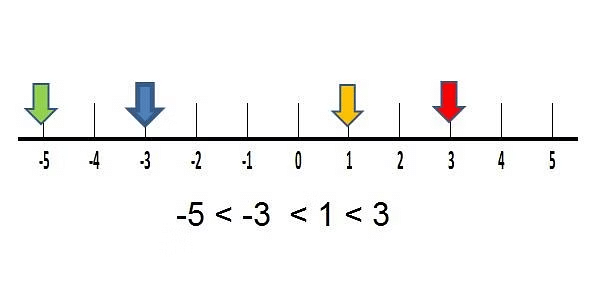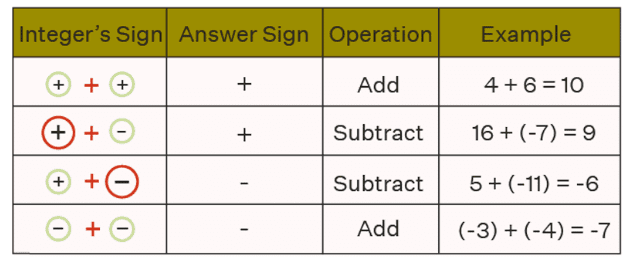CTET & State TET Exam > CTET & State TET Notes > Mathematics & Pedagogy Paper 2 for CTET & TET Exams > NCERT Summary: Integers
Integers Summary Class 6 Maths Chapter 1

Integers
- Integers are a type of number that includes all the whole numbers and their negative counterparts, as well as zero.
- Positive integers are numbers greater than zero, such as 1,2,3,…
- Negative integers are numbers less than zero, such as −1,−2,−3,….
- Zero is neither positive nor negative.

Predecessor and Successor
- These are terms used to describe the relationship between numbers in a sequence.
- Predecessor: The predecessor of a number is the number that comes immediately before it in a sequence or number line.
To find the predecessor of an integer, subtract 1 from it.
Example 1: The predecessor of 7 is 7−1=6.
Example 2:The predecessor of −3 is −3−1=−4. - Successor: The successor of a number is the number that comes immediately after it in a sequence or number line.
To find the successor of an integer, add 1 to it.
Example 1: The successor of 5 is 5+1=6.
Example 2:The successor of −2 is −2+1=−1.
Representation of integers on a number line

- All the positive integers lie to the right of 0 and the negative integers to the left of 0 on the number line.
- In order to mark -5 on the number line, we move 5 points to the left of zero.
- In order to mark +5 on the number line, we move 5 points to the right of zero.
Ordering of Numbers
- On the number line, the number occurring on the right is greater than that on the left and the number on the left is smaller than that on the right.
- 2> 1, as 2 is to the right of 1.
- 0 >-2, as O is to the right of -2.
- -5>-8, as-5 is to the right of -8.

Addition and Subtraction of Integers
- To add two negative integers, we add the corresponding positive integers and retain the negative sign with the sum. For example: 6 + (-5) = -(6 + 5) = -11
- To add a positive integer and a negative integer, we ignore the signs and subtract integer with smaller numerical value from the integer with larger numerical value and take the sign of the larger one.
- Two integers whose sum is zero are called additive inverse of each other.
- To subtract an integer from a given integer, we add the additive inverse of the integer to the given integer.

Addition of Integers on a Number Line
Let us add 3 and 5 on number line.

On the number line, we first move 3 steps to the right from 0 reaching 3, then we move 5 steps to the right of 3 and reach 8. Thus, we get 3 + 5 = 8.
Subtraction of Integers on a Number Line
- Subtract -4 from -5.
–5 – (–4) is same as –5 + (4), as the additive inverse of –4 is 4. We move 4 steps to the right on the number line starting from –5.

The document Integers Summary Class 6 Maths Chapter 1 is a part of the CTET & State TET Course Mathematics & Pedagogy Paper 2 for CTET & TET Exams.
All you need of CTET & State TET at this link: CTET & State TET
|
82 videos|300 docs|69 tests
|
FAQs on Integers Summary Class 6 Maths Chapter 1
| 1. What are integers and how are they represented on a number line? |  |
Ans.Integers are a set of whole numbers that include positive numbers, negative numbers, and zero. On a number line, integers are represented as points that are evenly spaced from each other. The zero is at the center, with positive integers to the right and negative integers to the left.
| 2. How do you add two integers with different signs? |  |
Ans.To add two integers with different signs, you need to subtract the absolute values of the integers and take the sign of the integer with the larger absolute value. For example, if you add -3 and 5, you subtract 3 from 5, which equals 2, and since 5 has a larger absolute value, the result is positive 2.
| 3. What is the rule for subtracting integers? |  |
Ans.The rule for subtracting integers is to add the opposite of the integer that is being subtracted. For example, to subtract -4 from 3, you would calculate 3 + 4, which equals 7. Thus, subtracting a negative integer is the same as adding its positive counterpart.
| 4. Can you explain the concept of absolute value in relation to integers? |  |
Ans.Absolute value refers to the distance of an integer from zero on the number line, regardless of direction. It is always a non-negative value. For example, the absolute value of both -7 and 7 is 7, represented as |7| = 7 and |-7| = 7.
| 5. How can integers be applied in real-life situations? |  |
Ans.Integers are used in various real-life situations, such as temperature scales (where below zero indicates negative temperatures), financial transactions (where debt can be represented as negative integers), and elevation levels (where heights above sea level are positive and below sea level are negative).
Related Searches






















